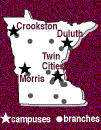
-
Overview
The University of Minnesota, with its four campuses, is one of the most comprehensive universities in the country and ranks among the most prestigious universities in the United States. It is both the state land-grant university, with a strong tradition of education and public service, and a major research institution, with scholars of national and international reputation.
The University of Minnesota, Twin Cities--a classic Big Ten campus in the heart of the Minneapolis-St. Paul metropolitan area. The largest of the four campuses, it is made up of 19 colleges and offers 161 bachelor's degrees, 218 master's degrees, 114 doctoral degrees, and 5 professional degrees. With a host of nationally recognized, highly ranked programs, the University's Twin Cities campus provides a world-class setting for lifelong learning.
The University of Minnesota, Duluth (UMD)--offers 11 bachelor's degrees in 70 majors. Its School of Medicine offers a two-year basic science program leading to an M.D. through the University of Minnesota, Twin Cities, Medical School. In addition, UMD offers graduate programs in 18 different fields. UMD ranks among the top Midwestern universities according to U.S. News & World Report.
The University of Minnesota, Morris (UMM)--offers baccalaureate degrees in 27 majors and course work in seven preprofessional areas. UMM's distinctive mission and strong academic quality have repeatedly received national recognition in feature articles in Money magazine, U.S. News & World Report,and Kiplinger's Changing Times and high rankings in Peterson's Guide to Competitive Colleges and the Fiske Guide to Colleges. It is one of only seven public institutions ranked by the Carnegie Foundation as a national liberal arts college.
The University of Minnesota, Crookston (UMC)--offers 19 technical bachelor's and 14 associate's degrees. UMC was the first campus in the nation to issue laptop computers to all full-time students. Named a U.S. News & World Report 1999 Best College, UMC also has been featured as a national leader in innovative polytechnic education in the Washington Post, Atlanta Constitution, St. Paul Pioneer Press, IBM Higher Education, and Microsoft in Higher Education.
The University also offers courses and degrees at University Center Rochester, a joint program of MnSCU and the University of Minnesota. Other important parts of the University are the Supercomputing Institute in Minneapolis, Hormel Institute in Austin, Lake Itasca Forestry and Biological Station in Itasca State Park, Cloquet Forestry Center, Cedar Creek Natural History Area near Bethel, Rosemount Research Center, Horticultural Research Center at Excelsior, Minnesota Landscape Arboretum near Chanhassen, Sand Plain Research Farm at Becker, Soudan Underground Research Site, and agricultural experiment stations at Rosemount, Crookston, Grand Rapids, Morris, Lamberton, and Waseca. Through the University of Minnesota Extension Service, the University is present in each of Minnesota's 87 counties.